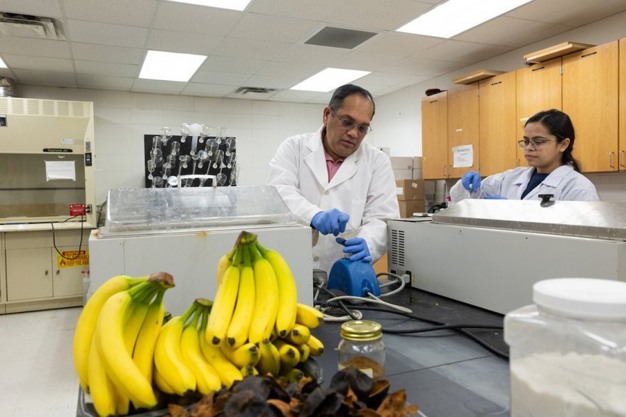Bananas are one of the most popular and widely consumed fruits in the world. They are also the fourth most grown crop in the world, trailing only rice, wheat and corn. What could this tropical fruit have to do with fighting the ongoing plastic waste crisis?
For the past few years, Srinivas Janaswamy, associate professor of food chemistry in South Dakota State University's Department of Dairy and Food Science, has been researching how different agricultural byproducts, like banana and avocado peels, can be utilized to create biodegradable films — plastic-like packaging materials that will decompose in the environment. With very little plastic being recycled, most end up in landfills or littered in the greater environment, creating serious health and environmental consequences. Finding a plastic-like alternative that will decompose relatively quickly would go a long way in fighting the ongoing plastic waste crisis.
"Overall, the lack of biodegradability of plastics and its effects on human health and the environment warrant remediation measures with a viable alternative," Janaswamy said. "Banana peels stand out as a promising and inexpensive material."
Banana byproducts
Because bananas are one of the most widely grown fruits in the world, they create a tremendous amount of byproducts. Around the world, banana plantations produce about 220 tons of residue per 2.5 acres. Banana residue is made up of predominantly lignocellulosic material, the key ingredient to creating biodegradable films.
"Lignocellulosic residue from biowaste stands out as a viable alternative to make bioplastics due to its robust structure, biodegradability, low density and non-toxicity," Janaswamy noted.
Banana residue — the peel — nearly always goes unused, making it a near-perfect byproduct to utilize for this work. Environmentally friendly plastic-like packaging material is desperately needed. In a new study, Janaswamy and Mominul Hoque, a graduate research assistant at SDSU, demonstrated how banana peels can be utilized to create biodegradable films — something that may one day replace petroleum plastic as the dominant food packaging material.
 Janaswamy, left, preparing lignocellulosic solution from the banana residue for film preparation with one of his graduate research assistants, Sumi Regmi, pictured right.
Janaswamy, left, preparing lignocellulosic solution from the banana residue for film preparation with one of his graduate research assistants, Sumi Regmi, pictured right.
From peel to "plastic"
The research team first turned the used peels into a bran using a blender. Then, as Janaswamy and his team had done previously with avocado peels, spent coffee grounds and switchgrass, they extracted the lignocellulosic material using a chemical treatment process. The extracted fibers then underwent bleaching, distilling and treatment before being prepared into a film. After drying, the film's properties were tested.
"The films are strong and transparent, and more importantly, biodegrade within 30 days at 21% soil moisture content," Janaswamy said. "The finding opens up new possibilities for banana peel and other fruit processing byproducts in designing and developing plastic-replacing biodegradable packaging."
For more information:
South Dakota State University
Brookings, South Dakota
Tel.:1-605-688-4121
